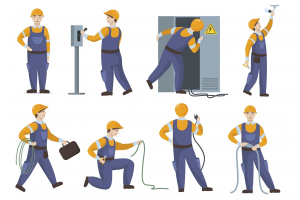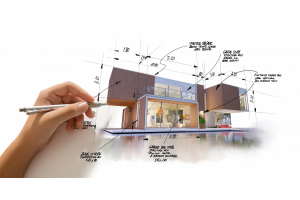
Construction Management-At-Risk, or CMAR, is one of several project delivery methods. Its competition is Hard-Bids (Design-Bid-Build), Construction Management Agency, and Design-Build. In this document, we will be looking at CMAR’s attributes and how CMAR compares to other delivery methods.
What is CMAR?
CMAR can be identified by four main features.
- The Owner hires a Construction Manager, or CM, during the design and development phase that goes on to work in construction and post-construction phases as well.
- The CM works as a consultant during this design and development phase working collaboratively with the design team.
- The CM works as a general contractor during the construction phase. The CM enters into subcontracts with each trade that works on the construction and is liable to the losses in those contracts. These subcontracts are contract agreements for construction work in some parts of the project.
- The CM has to complete the project within a timeline under a Guaranteed Maximum Price agreed to in their contract.
CMAR and Design Phase Collaboration
By choosing CMAR, the owner starts the project by hiring two firms. A design firm, and a construction management firm. The design firm carries most of the weight in the design and development phase, while the CM helps in key decisions.

What makes this collaboration advantageous?
Several advantages can be identified as value additions by choosing CMAR and facilitating this collaboration between the CM and the design firm.
- The CM is made aware of all key design elements and decisions at the inception stage. Some design elements may be problematic to construct. The CM would be able to quickly bring the issue to light and solve the design element before it is integrated into budget and scheduling calculations.
- The CM can predict the cost of design elements better than the owner or the design firm. By using valid data collected from previous projects and using construction management and financial software, CMs can calculate costs, constructability, timelines, and other important factors in real-time. These calculations become important feedbacks in the design process which end up influencing the final budgeting and scheduling decisions.
- The CM understands the design elements better by being involved. There is less or no misinterpretation of the design firm’s vision or objectives. The CM understands the intent behind each piece of the project.
- There is improved efficiency in CMAR compared to other methods. In this case, the general contractors are not going to send back design plans for revision due to some new problem identified by the construction team. This is already done during the design phase.
- The CM contacts subcontractors and receives the bids for their construction contracts in this design phase. These bids are then reviewed and the design is changed to keep the project on budget and schedule.
CMAR and the Construction Phase
The second main feature of CMAR shows up in the construction phase where the CM works as a general contractor. The responsibilities of a CM can be simplified as below.
- The CM announces a public bid for subcontracts in the project. This ensures transparency and allows for open-book accounting.
- The bids have to be selected based on qualification instead of the lowest price.
- The CM has to bear any losses if a subcontractor fails the contract and also deal with other liabilities and responsibilities such as checking for construction licenses.
- The CM has to ensure the project stays within the budget and schedule, otherwise, they are liable and at risk from the owner.
- The CM has to bear any extra costs of the project that exceed the Guaranteed Maximum Price as per their contract with the owner.
CMAR’s Advantages
Better Budgeting
CMAR is suitable for projects with constrained budgets because the general contractor can provide valuable feedback during the design phase. This feedback and the subcontractors’ bids received by the CM allow owners to understand the costs of their project.
Owners understand the costs of each design element early on and make appropriate budgeting decisions. Compare it to the Design-Bid-Build method where the owner will only figure out the costs of the project after the complete design has been finished.
Transparency
CMAR has completely open-book accounting. All subcontractor bids are made public. The owner can communicate with the CM to understand how each cent has been spent inside the project.
Complex Projects
CMAR’s early collaboration adds a lot of value to projects such as complex renovations, complex additions, and projects with a lot of moving parts. For example, a construction project in a specific community or a busy campus will have impacts on the budget and schedule of the project. The CM’s involvement in the design phase will have made sure these issues were represented and adjusted in the budget beforehand.

Quality
CMAR does not use the lowest bid method at any stage. The CM is chosen per their qualification and not their fees. The subcontractors are chosen based on a variety of factors such as quality and safety instead of the lowest bid. The lowest bids often reduce quality, create inaccuracies, or have misinterpreted the design requirements.
Easier for Owners
First, the owner only has to go into contract with two firms; the design firm and the Construction Management firm. Fewer contracts mean less work, simpler work, and fewer liabilities.
Second, the owner does not have to bear any extra unforeseen costs that surpass the Guaranteed Maximum Price as quoted by the CM.
Third, the owner is not liable to all the subcontracts (potentially hundreds) and having to ensure that the subcontracts complete within budget and schedule.
CMAR’s Disadvantages
The following list includes the main disadvantages possible while opting for CMAR.
- The Guaranteed Maximum Price can be ambiguous in its scope. It requires comprehensive communication between the CM and the owner to understand what falls under it and what does not. Anything that falls outside it cannot be held accountable to the CM. The owner will have to pay those costs.
- CMAR loses its main advantages if the design team and the CM do not find a collaborative attitude. If they butt heads with each other, continuously changing orders will drive up costs.
- Smaller and simpler projects are not suitable for CMAR where early collaboration is not much needed, and only increases the cost of the project.
- The CM becomes a critical part of the project. If a CM leaves during the project, not only the owner has to hire a new CM, but all the advantages of CMAR turn into lost costs.


